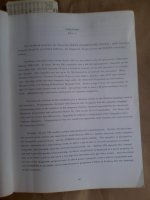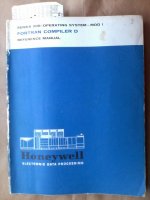Hi Kev,
Yes, the control panel has now been spotted in my contact's parent's shed, so it definitely exists. He lives on the outskirts of Los Angeles but I don't know where his parents live. If you can give me an idea where your friend is and for how long then I could contact my chap about this offer to see whether there could be an opportunity. Regardless of the outcome thanks for the offer.
I think the H120 and H125 may have been the models that used early integrated circuits in place of transistors as the central processor cabinets looked smaller, holding only three racks instead of four like the H200. If this is so then my machine will be more like these models as I have those early ICs in large numbers. The memory unit is made from genuine H200 circuit boards though. If you have anything at all from your time working on the H125 then it may be of interest to me. I don't even have any printouts from my days working on the H200.
I haven't done any work on the project for almost two years now, but I am just preparing to start again. I turned the power supplies on a couple of days ago and was rewarded with the smell of dust burning on the hot components. My temporary bench power supplies don't provide enough current to operate the complete memory system, so I am considering adding booster batteries to them. The batteries will provide the extra current during test runs and then recharge from the power supplies between times. There's no point in my getting the components for a proper 1960's style mains transformer driven PSU until I know what the full load will be and the dimensions of the enclosure, so for now I'm using makeshift testbench PSUs. Nevertheless even these only use 1960's technology. With all the power being consumed I also need to add cooling fans to the memory. Once I've installed all the inhibit drivers the power consumption will rise about another 200 Watts.
The inhibit windings in the memory prevent a "1" being written to selected bits to form the required byte. To achieve this each inhibit winding passes through every core in an entire plane. Therefore in my 8k memory it goes through 8192 cores, which create a substantial amount of inductance. To overcome this inductance and form a correct pulse waveshape the drivers switch a relatively high voltage through series resistors to create an approximately constant current. The result is that to write all zero bytes to the memory about 200 Watts is burned off in those resistors. When I designed the backplane layout I took the precaution of positioning the inhibit drivers at the top so that the heat wouldn't affect any other components. However, H200 backplanes swivelled out of the cabinet for testing instead of sliding, so the memory unit is currently mounted on its side during construction and testing and my layout for normal operation isn't so effective. I need to place cooling fans directly adjacent to the inhibit drivers to draw air across them sideways. I have also bought an infrared thermometer to check for hot components when the unit is running. Spare parts are a distinct problem obviously, so I'd rather not abuse the parts that currently work.
I was wondering about the precise procedure for adjusting the memory to get it working properly as there are numerous variable elements provided in it to compensate for the variations in core memory manufacture at that time. Fortunately a former Honeywell engineer has contacted me and he still has a copy of the H200 engineer's reference book, which contains the memory adjustment procedures. I now have a copy of these from him, so that's another space in the jigsaw puzzle filled.
Building this machine is just a pastime for me when I have the time, so I am not hurrying to get the work done. The important thing is that I am collecting together in one place all the things needed to do it. The stuff that I have is all at least 45 years old, so a few more years won't affect it much.




